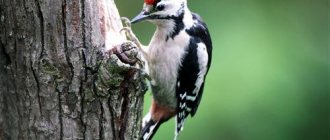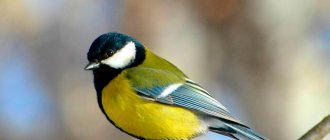The nightingale is an order of passerines that has only 2 species: the common nightingale and the southern nightingale. Everyone is known for their beautiful singing, thanks to which they are often kept in captivity.
Nightingale is a small bird. Its size is slightly larger than that of a sparrow. The color of the bird is unremarkable: brownish-brown, brownish-gray. Quite long and rounded tail.
Southern Nightingale
The common nightingale lives in central Russia and southern Siberia. An absolutely boring and uninteresting bird, at first glance. They love her not for her appearance, but for her voice.
But what can surprise a gray, nondescript bird with a beautiful voice? As it turns out, the common nightingale keeps many secrets and mysteries.
Loyal to your home
Nightingales live in the same place all their lives (which is about 10 years). After wintering in hot Africa, they return to their nests. And the young settle next to the nest in which they were born. The thing is that they are extremely picky in choosing habitats. After a long choice of housing, they do not “want” to return to an empty, uninhabited place.
Lifestyle
The nightingale bird has certain habits by which it can be recognized.
Habitats
Mixed forests with high humidity are where the nightingale lives. This cautious bird has a wide nesting range, covering a significant area from the western border of the country to the bed of the Yenisei. In the south, the border of the distribution zone passes through the Caucasus and Kazakhstan. “Night singers” prefer to spend the winter in Southern Iran, African countries and Saudi Arabia.
Regardless of the region of residence, birds have an interesting feature - they improve their singing talent throughout their lives
Here's where the nightingale still lives:
- forest parks with lakes and ponds;
- city squares with ponds;
- forest-steppe of the Krasnoyarsk Territory;
- southern border of the taiga.
Note! When raising poultry at home, it is important to create a microclimate for it that is as close as possible to the wild.
Catering
The nightingale is a bird that feeds on plant and animal food. Plants, nuts, seeds, insects - this is what the nightingale eats in natural conditions. In autumn, the bird goes on a real hunt, looking for insects prepared for winter in the fallen leaves: beetles, maggots, ants, caterpillars. Capable of catching flies in flight and using a sharp claw to extract bugs from tree bark. The birds' favorite delicacies include wild cherries, elderberries, and currants.
Note! Small caterpillars are used to feed the chicks.
Migratory or wintering bird
Fans of nightingale singing are interested in whether the nightingale is a migratory bird or not, and whether it is possible to hear its trills in the winter frost. The tiny singer makes annual migrations in the fall, flying south to return to their native nests in the spring, with the first warming.
African countries located south of the equator are where many nightingales spend the winter. The birds are warm there, they are provided with food, but despite this they do not sing.
Castle house
When a nightingale arrives from wintering, it waits up to 5 days and begins to sing all day, taking a short break. This lasts up to two weeks. This is necessary in order to attract the female to your home. Afterwards, the bird begins to sing only at night in order to drive away other males from the home. It is also worth noting that he mercilessly drives out all other birds from his territory.
Singer's professionalism
The changes in tones of a nightingale's song can be the envy of any experienced vocalist. The nightingale's repertoire is equivalent to 180-300 types of tones . A nightingale's song can contain up to 24 tribes . A knee is an alternating series of sounds. But this is not so much compared to the number of tribes of an older nightingale (40 tribes). The thing is that females choose the most experienced singer for mating. Therefore, the older the bird, the greater the chance of having offspring.
Nutrition, maintenance, breeding of the nightingale
The main part of the nightingale's diet is live food - ant eggs, insects, worms, small spiders. Also, nightingales willingly peck ripe berries; you can feed the birds with grain mixtures, maggots, grated carrots, white cracker crumbs, and so on.
photo: White-browed nightingale
Nightingales are often kept in captivity, but it is worth remembering that these birds are very shy. The caught nightingale struggles in the cage for the first time, so it is recommended to cover it with thick material and at first approach the new pet less often. The cage dimensions should be 40x60x30 cm; it is better to choose cages with wooden rods. Equip them with drinkers, feeders, perches, toys, and a house. The nightingale does not sing all year round; in autumn and winter the birds rarely delight with their trills. During this period, they are transferred to surrogate food - a mixture of white crackers with ant eggs and grated carrots. In captivity, representatives of this species live 3-5 years.
In nature, the nightingale makes a nest in the roots of trees or shrubs; it is built from thin twigs, leaves, grass stems, and roots. In one clutch there are from 4 to 6 eggs of a brownish color, without mottling. After 14-15 days, the chicks are born and are fed by both parents.
photo: Nightingale - the best singer among songbirds
Big appetites
The common nightingale feeds mainly on insects (bugs, leaf beetles, weevils and click beetles). In cold weather, when all the insects hide underground, the nightingale does not disdain berries and seeds.
It would seem that there is nothing unusual or surprising about this. But if some ant has enormous strength and is able to lift 10 times more weight than itself, then the nightingale is able to eat almost 90% of its body weight. This is vital for him to compensate for all the energy he expends while singing.
Presentation “Interesting facts about nightingales” presentation for a lesson on the world around us (senior group)
Slide 1
Interesting facts about nightingales Compiled by E.A. Levitskaya.
Slide 2
In the green branches of the nightingale, the nightingale sings songs to us all night long. Songs flow endlessly, There is no better singer in the forest! May has arrived. The leaves on the trees and bushes have become stronger, opened up, and a light drop of dew or rain can hold on them without rolling off. People say: “Nightingales fly to our region when they can drink from a birch leaf.”
Slide 3
Nightingale is a small bird. Its size is slightly larger than that of a sparrow. The color of the bird is unremarkable: brownish-brown, brownish-gray. Quite long and rounded tail.
Slide 4
The common nightingale lives in central Russia and southern Siberia. An absolutely boring and uninteresting bird, at first glance. They love her not for her appearance, but for her voice. But what can surprise a gray, nondescript bird with a beautiful voice? As it turns out, the common nightingale keeps many secrets and mysteries.
Slide 5
Faithful to their home, Nightingales live in the same place all their lives (which is about 10 years). After wintering in hot Africa, they return to their nests. And the young settle next to the nest in which they were born. The thing is that they are extremely picky in choosing habitats. After a long choice of housing, they do not “want” to return to an empty, uninhabited place.
Slide 6
Singing lessons Parents have been teaching their chicks truly beautiful singing since childhood. But even more surprising is the fact that young people spend the rest of their lives trying to imitate the older generation, considering them more experienced and skilled craftsmen.
Slide 7
The professionalism of the singer The changes in the tones of the nightingale's song can be the envy of any experienced vocalist. The nightingale's repertoire is equivalent to 180-300 types of tones. The song of a nightingale can contain up to 24 knees. A knee is an alternating series of sounds. But this is not so much compared to the number of tribes of an older nightingale (40 tribes). The thing is that females choose the most experienced singer for mating. Therefore, the older the bird, the greater the chance of having offspring.
Slide 8
House on a Castle When a nightingale arrives from wintering, it waits up to 5 days and begins to sing all day, taking a short break. This lasts up to two weeks. This is necessary in order to attract the female to your home. Afterwards, the bird begins to sing only at night in order to drive away other males from the home. It is also worth noting that he mercilessly drives out all other birds from his territory.
Slide 9
In dense thickets of willow and alder, on the slopes of deep ravines, where icy springs flow, nightingales build nests and hatch their chicks. At the end of May, four to six greenish-gray eggs appear in the nightingale's nest. The female incubates them for two weeks. To feed, she flies out of the nest for a short time, then sits down again on the clutch. When the chicks hatch, nightingales feed them caterpillars, larvae and worms.
Slide 10
The common nightingale feeds mainly on insects (bugs, leaf beetles, weevils and click beetles). In cold weather, when all the insects hide underground, the nightingale does not disdain berries and seeds. It would seem that there is nothing unusual or surprising about this. But if some ant has enormous strength and is able to lift 10 times more weight than itself, then the nightingale is able to eat almost 90% of its body weight. This is vital for him to compensate for all the energy he expends while singing.
Slide 11
At the end of August, nightingales gather in small flocks. At this time, berries ripen in the forests, and birds eat them with pleasure, they especially like elderberries. At the beginning of September, birds fly to warmer climes.
Slide 12
Long flights Nightingales fly to hot Africa for the winter. Their flight begins in central Russia and ends in the Congo. This is 6500 km on the road. How much time and how much strength these small and fragile birds need to overcome this path remains a mystery.
Slide 13
List of sources used 1. https://vashechudo.ru/malchishkam/raskaz-pro-solovja-dlja-detei-1-2-klas.html 2. https:// obshe.net/posts/id1064.html 3. https ://vashechudo.ru/malchishkam/raskaz-pro-solovja-dlja-detei-1-2-klas.html 4. https:// www.chudesnayastrana.ru/ptitsi-solovey.htm 5. https://vivareit .ru/samye-interesnye-fakty-pro-solovev / 6. https://komotoz.ru/photo/zhivotnye/solovey.php
Faster than the wind
Nightingales are quite fast birds. On average, their speed can reach up to 50 km/h . Of course, this is not comparable to the speed of the needle-tailed swift (111 km/h), but for an ordinary small bird the speed of the nightingale is amazing.
Also, people have admired the nightingale since ancient times, and there are many interesting and extremely curious facts about how people interacted with these amazing birds.
Of course, the fact that to this day they are put in a cage to enjoy the wonderful singing of the nightingale every minute will not surprise anyone. But there is something that few people know:
- In the ancient East, the singing of the nightingale was especially valued. Nightingales lived in cages in the palaces and castles of especially emperors and nobles. It was believed that the nightingale with its trill calls for good luck and prosperity to its owners. But ordinary people could not afford to have a nightingale.
- Joseph Helfrich (American astronomer) discovered an asteroid in the main belt group in 1911. He named this asteroid "Lucinia", which means "nightingale" in Latin.
- In Kursk (Russia, Kursk region) an entire museum has been dedicated to the nightingale, which is called the “Kursk Nightingale”.
- In the 19th century, catching nightingales was considered a very profitable business. When the ranks of birds began to thin out, a decree had to be passed banning the catching of nightingales. Especially in the Kursk, Ryazan and Kyiv provinces, where nightingales were especially valued.
- In some cuisines around the world, the nightingale was used as a dish. Of course, basically, the love for the nightingale was devoid of gastronomic overtones. But, for example, in Germany they served pate made from nightingale tongues. And in some European countries they loved only nightingale meat.
- Of course, traditional medicine could not ignore such an amazing bird. It was believed that nightingale meat could cure ailments. Be it anemia (anemia), chronic fatigue (constant desire to sleep), abdominal pain and much more. They also gave the nightingale’s meat magical overtones. It was believed that after tasting it, a person would be able to understand the language of animals and birds, cause rain and see the future. Many people took nightingale meat to discover their unique talent for singing, music, drawing or handicrafts.
This is such an amazing nightingale. It would seem that a small bird, but how many secrets and mysteries it keeps within itself.
Description and origin of the species
The nightingale is a bird of the Nightingale genus of the Passeriformes family. The remains of the oldest nightingale that has survived to this day were discovered in Hungary; scientists have proven that they are more than 12 million years old!
The gray-olive nightingale does not have an interesting appearance, but it sings melodiously and variedly
Among the Slavs it was considered a symbol of good luck. In the East, it was revered as a bird of happiness, there was a special profession of nightingale catchers, their task was to catch sweet-voiced beauties and present them as a gift to the imperial court.
These “singers” were also popular in Tsarist Russia. Then the number of birds decreased sharply, because each nobleman or nobleman sought to surpass others in the number of birds. Therefore, their catching was prohibited. Currently, the livestock numbers are not in danger.
Description
The common nightingale is a small bird, body length - 16-27 cm. Weight - up to 26 grams.
Description and characteristics:
- Modest plumage in olive-gray tones, which makes the birds resemble sparrows.
- The abdomen is lighter than the back and wings, the sides are gray. The tip of the tail has red spots.
- The beak is tiny and yellow.
- The eyes are beady, round, black, but due to the compact shape of the head they look quite large.
- The neck is flexible and mobile.
Note! During flight, the nightingale's tail is set straight.
Differences between male and female
In some species of nightingale, it is quite simple to distinguish representatives of different sexes by their plumage: in “boys” it is brighter and more saturated. Such are the ruby-throated, blue and red-breasted nightingales.
Other varieties are practically indistinguishable; these are the southern and eastern species. Males and females have the same color and size.
Striking singing is a distinctive feature of males; it is their main way of attracting females











